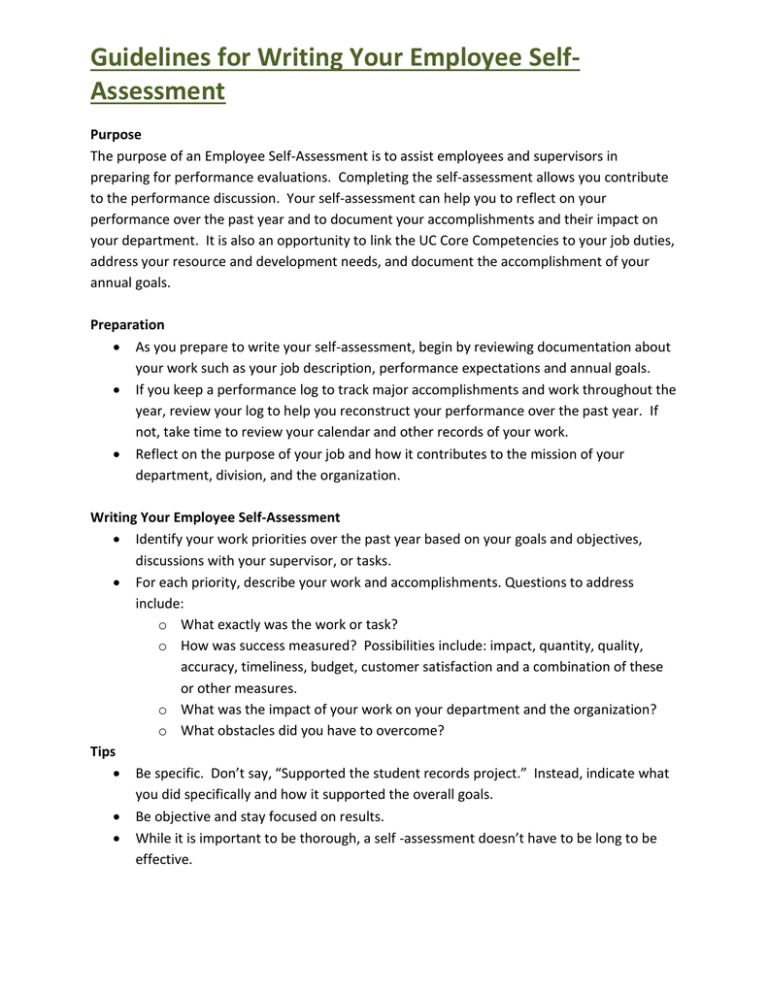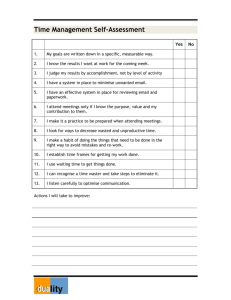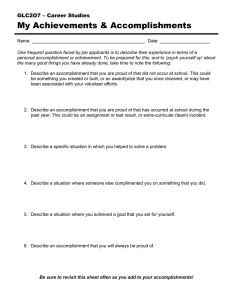Guidelines for Writing Your Employee Self
advertisement

Guidelines for Writing Your Employee SelfAssessment Purpose The purpose of an Employee Self-Assessment is to assist employees and supervisors in preparing for performance evaluations. Completing the self-assessment allows you contribute to the performance discussion. Your self-assessment can help you to reflect on your performance over the past year and to document your accomplishments and their impact on your department. It is also an opportunity to link the UC Core Competencies to your job duties, address your resource and development needs, and document the accomplishment of your annual goals. Preparation As you prepare to write your self-assessment, begin by reviewing documentation about your work such as your job description, performance expectations and annual goals. If you keep a performance log to track major accomplishments and work throughout the year, review your log to help you reconstruct your performance over the past year. If not, take time to review your calendar and other records of your work. Reflect on the purpose of your job and how it contributes to the mission of your department, division, and the organization. Writing Your Employee Self-Assessment Identify your work priorities over the past year based on your goals and objectives, discussions with your supervisor, or tasks. For each priority, describe your work and accomplishments. Questions to address include: o What exactly was the work or task? o How was success measured? Possibilities include: impact, quantity, quality, accuracy, timeliness, budget, customer satisfaction and a combination of these or other measures. o What was the impact of your work on your department and the organization? o What obstacles did you have to overcome? Tips Be specific. Don’t say, “Supported the student records project.” Instead, indicate what you did specifically and how it supported the overall goals. Be objective and stay focused on results. While it is important to be thorough, a self -assessment doesn’t have to be long to be effective. Sample Accomplishment Statements When reflecting on your accomplishments for the performance year, describe the task and how you were successful. If appropriate, also describe the impact of your work. Below are some sample accomplishment statements. Sample action verbs to use are listed on the next page. Accomplishment: Designed and led training of divisional staff on efficiently and accurately preparing reports. Staff members were able to apply what they learned which led to more rapid and accurate reports in direct support of our department goal to improve student services. Accomplishment: Successfully hired, coached, and mentored two employees who have recently passed probation. Employees are fully integrated into the department and making contributions to achieving team goals. Accomplishment: Successfully led the annual budget review for division management. Division managers were able to make significant financial decisions based on my thorough analysis and achieved cost savings based on my recommendations. Accomplishment: Prepared and distributed four effective presentations for Principle Investigators (PIs) as well as assistants on grant and award management. This improved relations with campus personnel and gave accurate procedural information to PIs which reduced duplicate requests and errors in submissions. Accomplishment: After discussing best practices with the team, I simplified and redesigned the process for updating records and implemented this change. By reducing the time required to update records, our team accomplished this task in half the time that was required last year. Sample Action Verbs to Use Use these action verbs as appropriate to help describe your work. administered advised analyzed approved arranged built communicated conceived conducted consolidated contracted controlled coordinated counseled created designed developed directed distributed edited eliminated engineered enhanced examined executed expanded facilitated formulated generated governed grouped guided implemented improved increased influenced initiated innovated installed invented investigated launched made managed maintained moderated monitored motivated negotiated organized originated performed planned prepared presented presided recommended recruited rectified redesigned reduced reorganized reshaped restructured revised scheduled secured solved streamlined strengthened systematized trained upgraded utilized wrote

